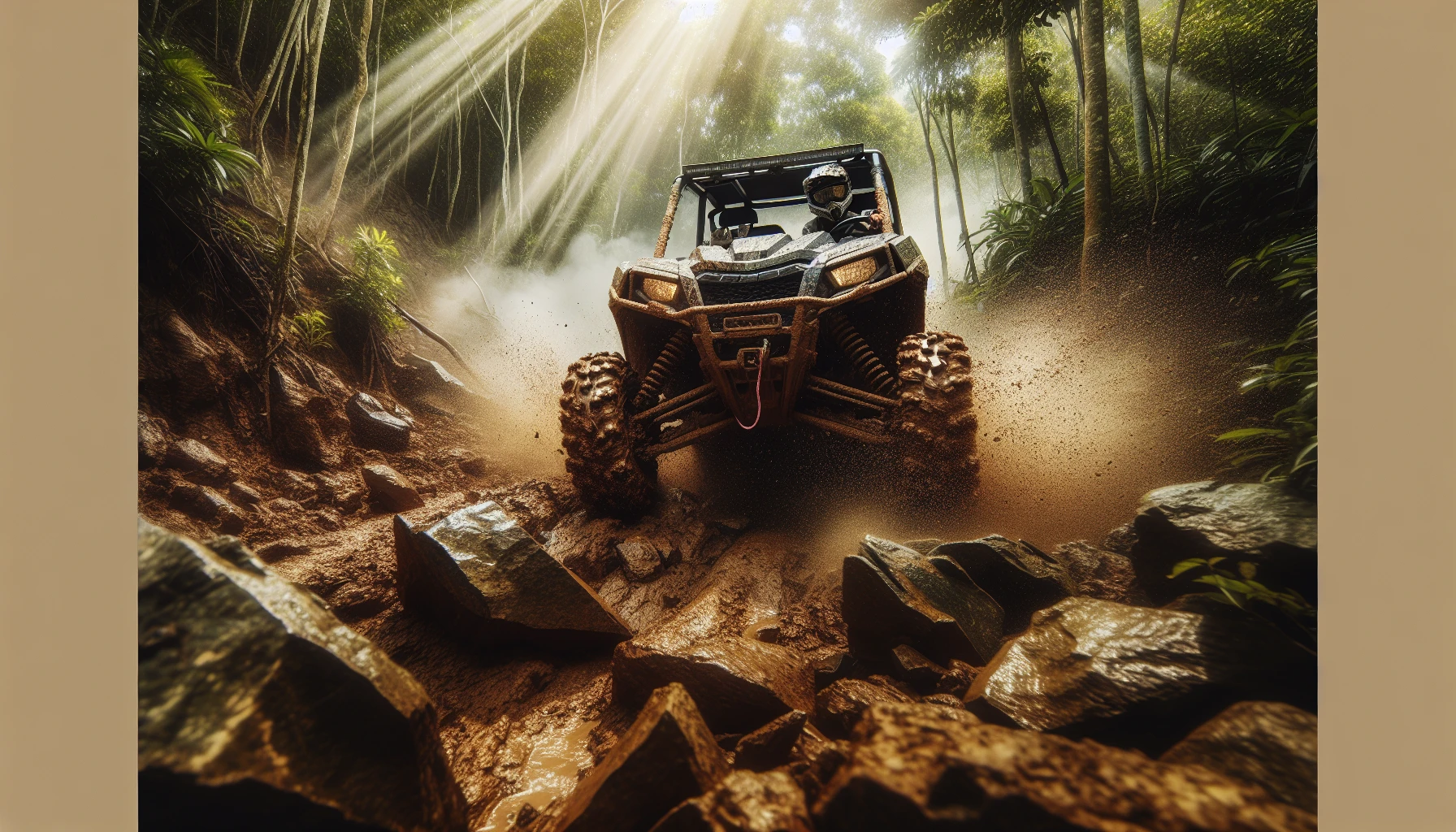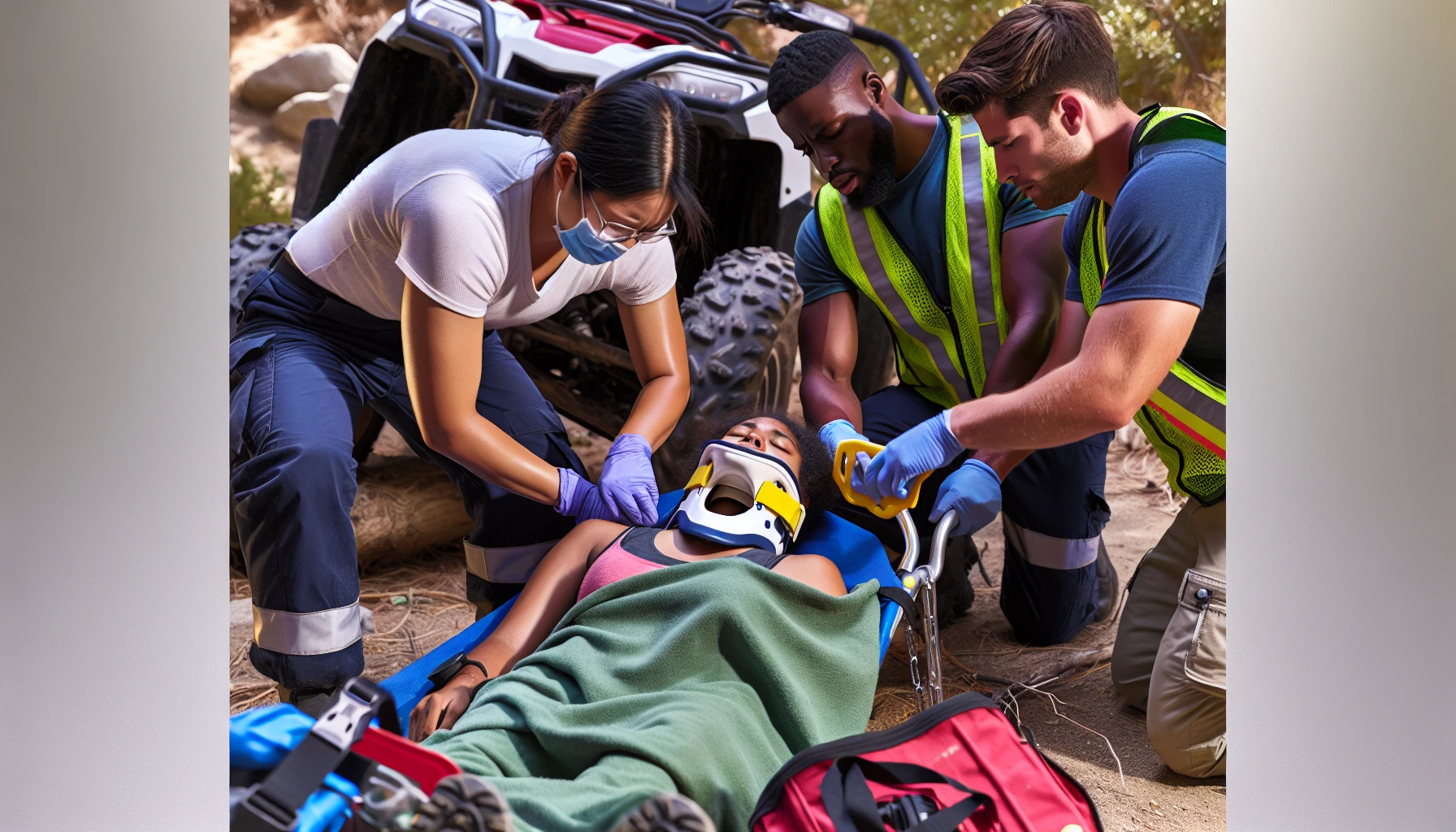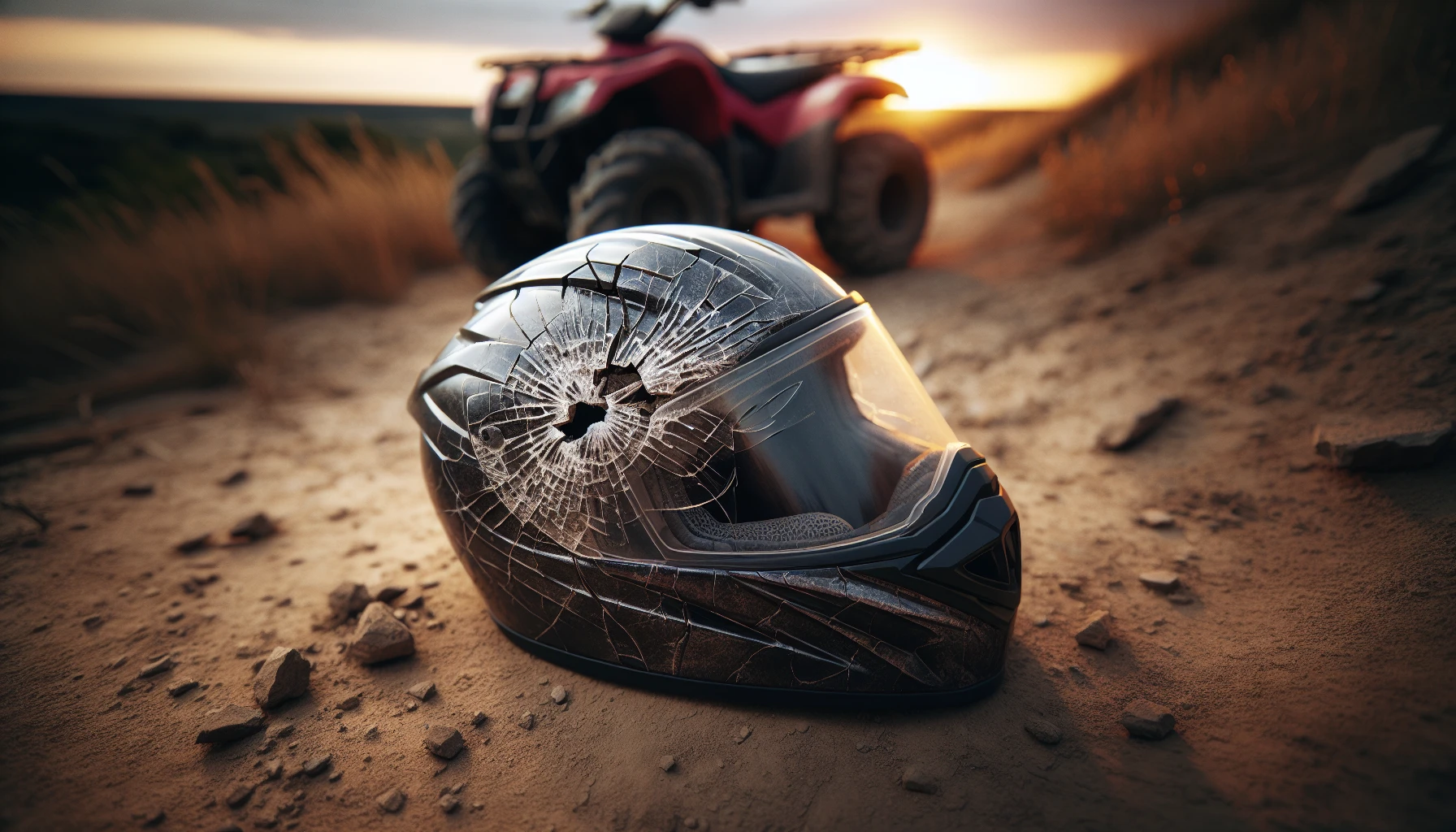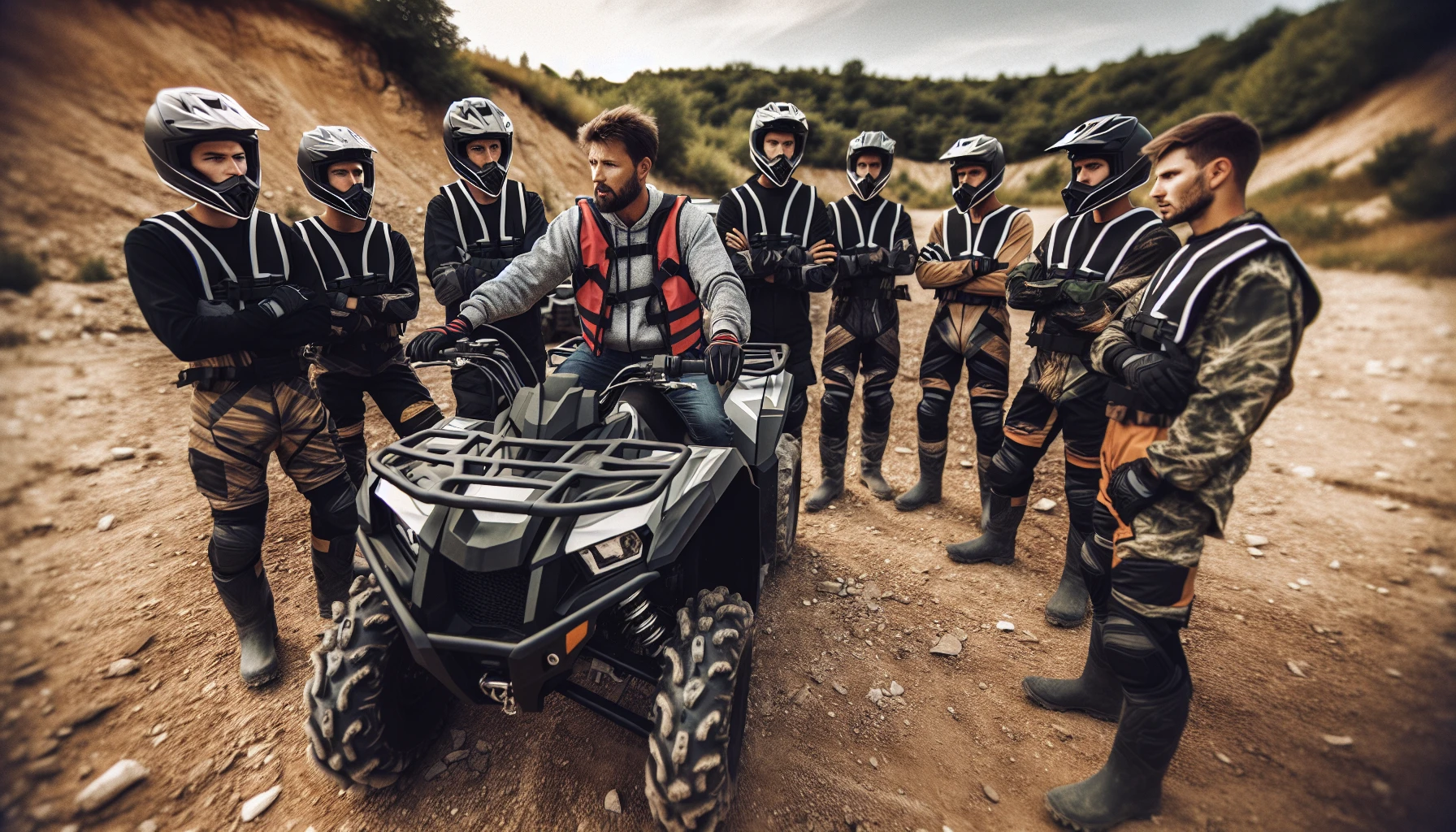Off-roading on side by side all-terrain vehicles (ATVs) offers an exhilarating way to explore the great outdoors, providing a thrilling experience for both novice and experienced riders alike. However, the excitement of this adventurous pastime comes with its own set of risks and challenges, making it essential for riders to be aware of potential hazards and take necessary precautions to ensure a safe and enjoyable experience.
In this blog post, we’ll explore the common side by side ATV accident injuries, the importance of wearing appropriate safety gear, and the legal aspects of ATV accidents. By understanding these factors and implementing preventative measures, riders can minimize the likelihood of accidents and common side by side ATV accident injuries, allowing them to fully enjoy their off-roading adventures.
Key Takeaways
- Side by Side ATVs present unique risks due to their design and capacity for multiple passengers.
- Severe injuries from side by side ATV accidents can include traumatic brain injuries, spinal cord injuries, fractures, and more.
- Taking preventative measures such as safety training and following manufacturer guidelines are essential for a safe off-roading experience.
Understanding Side by Side ATV Risks

Side by side ATVs, or all terrain vehicles, present unique risks due to their design and the ability to carry multiple passengers. Unlike traditional single-passenger ATVs, side by side ATVs have a more enclosed design and two or more seats, allowing passengers to ride together at speeds of up to 60 miles per hour. This capacity for additional riders, combined with design challenges, can lead to both stability and safety issues that are distinct from those faced by riders of traditional ATVs.
To mitigate these risks, we need to focus on two main concerns: design challenges and both the stability challenges, as well as passenger hazards. By examining these aspects, riders can gain a clearer understanding of the potential dangers associated with side by side ATV use and take appropriate precautions to minimize accidents and injuries.
Design and Stability Challenges
One of the primary concerns with side by side ATVs is the design and stability challenges that can contribute to hazardous outcomes, such as rollovers and collisions. These accidents are especially prevalent when side by side ATVs are driven on paved roads, where they are not designed to operate. Factors like incorrect weight distribution of passengers within the vehicle can further increase the likelihood of a rollover accident.
Mechanical failures on the trail can also pose dangers for passengers and other trail riders, potentially impeding drivers from navigating safely. To minimize the risk of accidents caused by design and stability challenges, riders should:
- Be mindful of weight distribution
- Avoid operating side by side ATVs on paved roads
- Ensure that their vehicle is properly maintained and inspected before use.
Passenger Hazards
Passengers in side by side ATVs face additional hazards that can lead to serious or even catastrophic injuries. One of the most significant risks for passengers is the potential for ejections and injuries resulting from inadequate seating or restraints. Approximately 80% of those killed in fatal ATV accidents had been partially or fully ejected from the vehicle. This shows us just how dangerous ATVs can be..
Primary factors leading to passenger ejections include:
- Failure to wear seat belts
- Extending arms outside the vehicle during a collision or rollover
- Consumption of alcohol or drugs, which can result in severe injuries
Ensuring that all passengers are securely seated and restrained with seat belts or harness systems is crucial for reducing the chances of injuries and fatalities in side by side ATV accidents.
Prevalent Injuries from Side by Side ATV Crashes

When accidents do occur, side by side ATV riders and passengers can sustain a variety of injuries, ranging from minor to life-threatening. Some of the most frequent injuries resulting from side by side ATV accidents include traumatic brain injuries, spinal cord injuries, and fractures. These injuries can have long-lasting effects on victims, impacting their ability to work, enjoy daily activities, and maintain their overall quality of life.
Next, we will detail each of these common injuries, including their causes, symptoms, and potential long-term effects. By understanding the consequences of these injuries, riders can better appreciate the importance of taking appropriate safety measures to minimize the risk of accidents and protect themselves and their passengers from sustain injuries.
Traumatic Brain Injuries and Concussions

Traumatic brain injuries and concussions are prevalent in side by side ATV accidents, often resulting from collisions or rollovers where riders and passengers are not wearing proper helmets. The symptoms of traumatic brain injuries can include:
- headaches
- confusion
- memory problems
- nausea
- impaired thinking, movement, or emotional functioning
Complications may include bleeding, physical damage to the brain, and long-term impairments in various areas of functioning.
Repeated concussions and head injuries can have serious long-term behavioral and cognitive repercussions. For this reason, wearing a helmet when riding side by side ATVs is non-negotiable, given it protects against traumatic brain injuries, concussions, and other head-related injuries.
Spinal Cord and Back Injuries
Spinal cord and back injuries can occur in side by side ATV accidents, leading to chronic pain, disability, or paralysis. Some of the most common spinal cord and back injuries resulting from side by side ATV accidents include fractures, spinal cord injuries leading to paralysis, and back injuries resulting in partial or total paralysis.
The potential long-term effects of spinal cord and back injuries caused by side by side ATV accidents may include paraplegia, numbness, tingling, loss of feeling, and complications such as herniated discs and nerve damage. To reduce the risk of these injuries, riders should wear protective gear, such as helmets and back braces, and follow safe riding practices.
Fractures and Broken Bones
Fractures and broken bones are common ATV injuries, often caused by high-speed impacts or rollovers in ATV accidents. Extremity fractures, spine fractures, and open fractures are the most commonly observed fractures in ATV accidents. The recovery time for common fractures from ATV accidents can vary depending on the specific fracture and the bone that is fractured, with some injuries being painful and taking a significant amount of time to heal.
It is imperative to consult with a medical professional for an accurate assessment of the recovery time based on the specific injury. Proper treatment, which may include rest, immobilization, and sometimes surgery, is essential for healing and minimizing the potential complications of fractures and broken bones resulting from side by side ATV accidents.
Safety Gear: Reducing the Risk of Severe Injuries

Wearing appropriate safety gear, such as helmets and protective clothing, can significantly reduce the risk of severe injuries in side by side ATV accidents. By investing in high-quality gear and using it consistently, riders can greatly enhance their safety and well-being on the trails.
Next, we will discuss how helmet use, eye protection, and protective clothing and body armor contribute to injury prevention during side by side ATV rides, as recommended by the Consumer Product Safety Commission.
Helmet Use and Eye Protection
Helmet use and eye protection are essential for preventing head and facial injuries in ATV accidents. Some effective safety gear for preventing side by side ATV injuries includes:
- Full-face helmets
- Protective goggles
- Gloves
- Boots
- Long sleeves
- Pants
In addition to protecting against direct impact or penetration, helmets can also help to mitigate the force of the impact, prevent the head from colliding with the steering wheel, dash, or cage, and safeguard against any debris kicked up from other vehicles or splashes.
Eye protection during ATV rides can also help to avoid facial injuries such as eye abrasions, lacerations, and foreign object injuries. By wearing a helmet and eye protection, riders and passengers can significantly reduce the risk of head and facial injuries in the event of an accident.
Protective Clothing and Body Armor
Protective clothing and body armor can help minimize the risk of cuts, abrasions, and other injuries during an ATV accident. Body armor provides additional protection to the upper body, including vital organs, in the event of an accident. This includes chest protectors, shoulder and bicep guards, and back protectors. Recommended brands for ATV safety gear include Flyracing, Alpinestars, and Highway 21.
By investing in and consistently wearing protective clothing and body armor, riders can better shield themselves from potential harm, ensuring a safer off-roading experience. Combined with helmet use and eye protection, these safety measures can greatly reduce the risk of severe injuries in utility terrain vehicle side by side ATV accidents.
Legal Aspects of Side by Side ATV Injuries
In the unfortunate event of a side by side ATV accident resulting in injuries, there are legal aspects that must be considered. Determining liability and seeking compensation for medical expenses and lost wages are vital steps in the aftermath of an accident.
Next, we will talk about how to determine liability in ATV accidents and how victims can seek compensation for injuries, medical expenses, and lost wages.
Determining Liability in ATV Accidents
Determining liability in ATV accidents requires a thorough investigation of the incident, including driver error, defective equipment, and other contributing factors. Driver error, such as negligence or reckless behavior, can play a key role in assessing liability in ATV accidents. If a driver causes an accident due to their actions, they can be held accountable for any injuries inflicted on other riders or passengers.
Defective equipment can also play a substantial role in assessing liability in ATV incidents. If an accident is caused by a design flaw, manufacturing defect, or lack of providing adequate equipment, the manufacturer may be held accountable for any injuries sustained. By understanding the factors that contribute to liability in ATV accidents, victims can better navigate the legal process and seek the compensation they deserve.
Recovering Compensation for Medical Expenses and Lost Wages
Victims of side by side ATV accidents may be eligible for compensation to cover medical expenses, lost wages, and other damages through insurance claims or personal injury lawsuits. The process of filing a personal injury lawsuit typically entails:
- Obtaining medical attention
- Assembling evidence
- Consulting with a lawyer
- Submitting a claim
- Endeavoring to reach a settlement
- Potentially continuing with litigation if a settlement cannot be achieved.
In ATV accident lawsuits, typically covered damages include:
- Medical expenses
- Lost wages
- Pain and suffering
- Property damage
- Punitive damages (in some cases)
By understanding the legal aspects of side by side ATV injuries and working with experienced ATV accident lawyers, victims can ensure they recover compensation for their losses.
Preventative Measures for Safer Off-Roading

Taking preventative measures, such as hands-on safety training and adhering to manufacturer guidelines, can help ensure a safer off-roading experience for side by side ATV riders and passengers. By being proactive in their safety measures and continually refining their skills, riders can minimize the risk of accidents and injuries, allowing them to fully enjoy their off-roading adventures.
Next, we will discuss the benefits of hands-on safety training and the importance of following manufacturer guidelines, both of which contribute to a safer and more enjoyable off-roading experience.
Hands-On Safety Training
Participating in hands-on safety training can help riders develop the skills and knowledge necessary to safely operate side by side ATVs and avoid accidents. Hands-on safety training typically includes hands-on demonstrations, exercises, and simulations to impart riders with the skills to properly operate and control their side by side ATVs, as well as navigate various terrains and obstacles safely.
In addition to honing skills, hands-on safety training offers several benefits for riders:
- Increases risk awareness
- Imparts safety knowledge
- Readies riders for emergencies
- Boosts confidence
By engaging in regular hands-on safety training, riders can become more adept at navigating the challenges of off-roading and minimize the risk of accidents and injuries.
Adhering to Manufacturer Guidelines
Following manufacturer guidelines for proper maintenance, weight limits, and passenger restrictions can help reduce the risk of side by side ATV accidents and injuries. Proper maintenance is essential in order to identify and address potential issues before they become safety hazards.
Weight limits and passenger restrictions are also important factors to consider, as overloading a side by side ATV or carrying too many passengers can compromise the vehicle’s stability and increase the likelihood of an accident. By adhering to these guidelines, riders can ensure a safer off-roading experience and minimize the risk of accidents and injuries.
Summary
Throughout this blog post, we’ve explored the various risks, injuries, and legal aspects associated with side by side ATV use. By understanding these factors and implementing preventative measures such as hands-on safety training and adhering to manufacturer guidelines, riders can minimize the likelihood of accidents and injuries, ensuring a safer and more enjoyable off-roading experience.
As riders and passengers venture out into the world of off-roading on side by side ATVs, let us remember the importance of safety, responsibility, and a commitment to continuous learning. By doing so, we can all enjoy the thrill of off-roading while protecting ourselves and those around us.
Frequently Asked Questions
What is the most common injury in the ATV?
Head and extremity trauma are the most common injuries suffered in ATV accidents, with broken bones and fractures also commonly sustained. TBIs, or traumatic brain injuries, are also often seen as a result of ATV accidents, and can be some of the most serious consequences.
What are the dangers of side-by-side?
Side-by-sides come with the risk of a rollover accident, leading to serious injuries like broken bones, traumatic brain injury and spinal cord injuries. It is important to be aware of these dangers when considering purchasing one.
Is a side-by-side safer than an ATV?
Side-by-side vehicles are twice as likely to cause injuries compared to ATVs, and offer features like roll cages, seatbelts and windscreens that make them safer options. Therefore, a side-by-side is generally considered safer than an ATV.
What safety gear should I wear when riding a side by side ATV?
When riding a side by side ATV, it is important to wear full-face helmets, protective goggles, gloves, boots, long sleeves, and pants for maximum safety.
How can I determine liability in a side by side ATV accident?
In order to determine liability in a side by side ATV accident, you should conduct a thorough investigation of the incident, assessing driver error, defective equipment, and other contributing factors.

